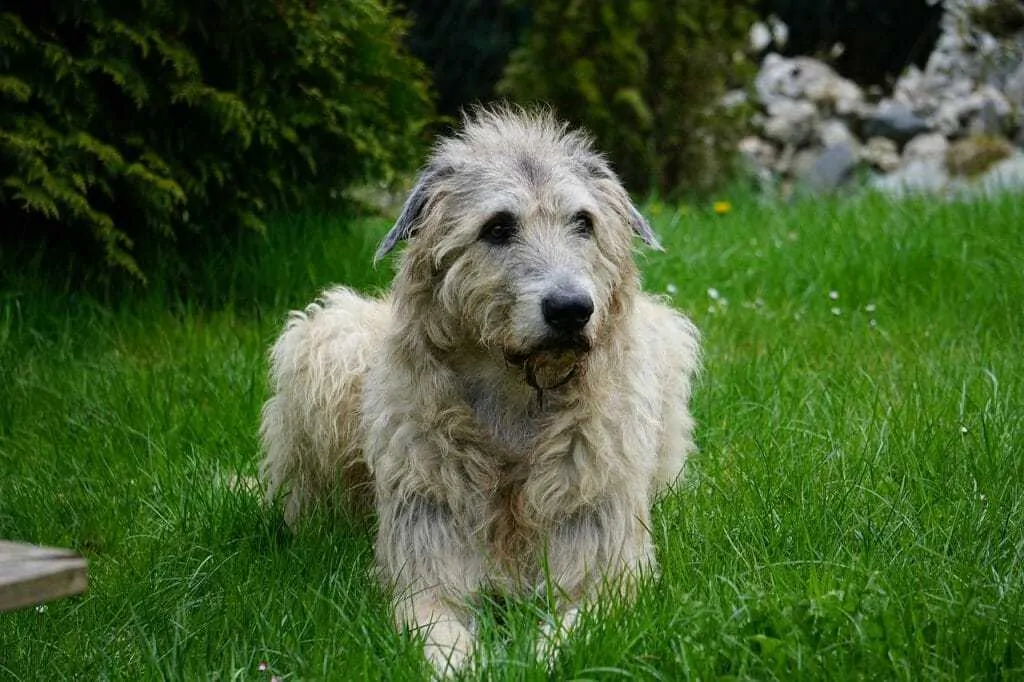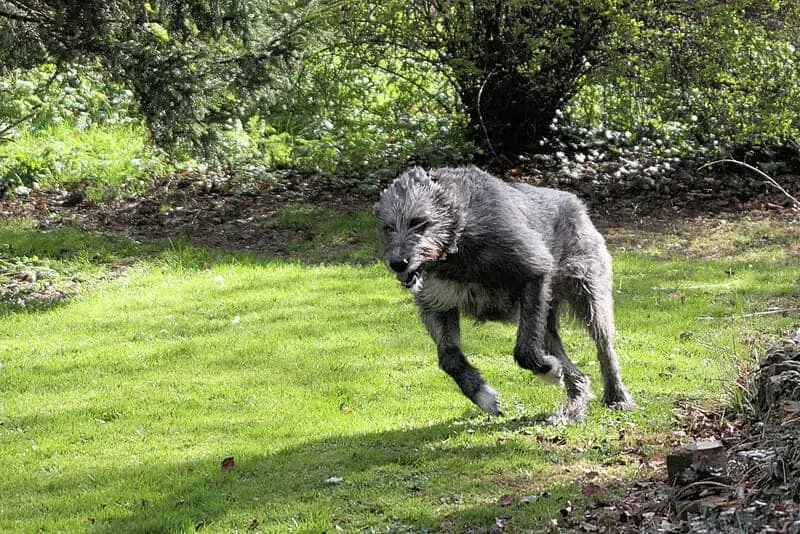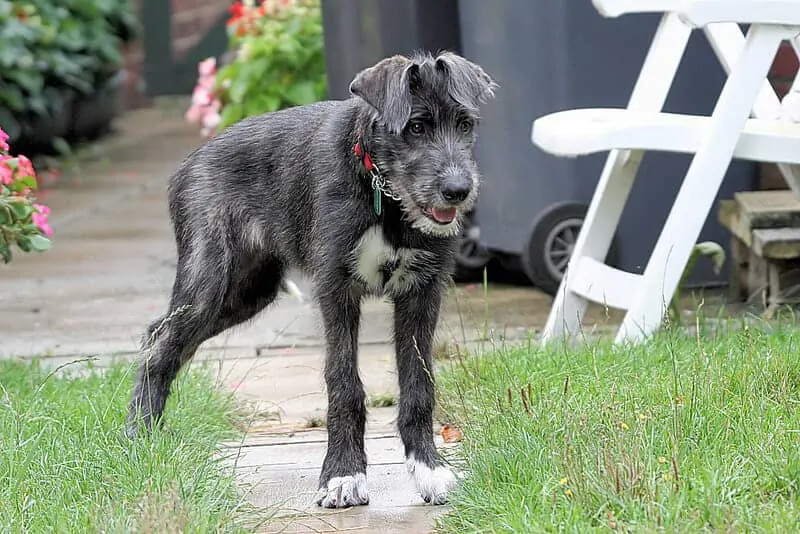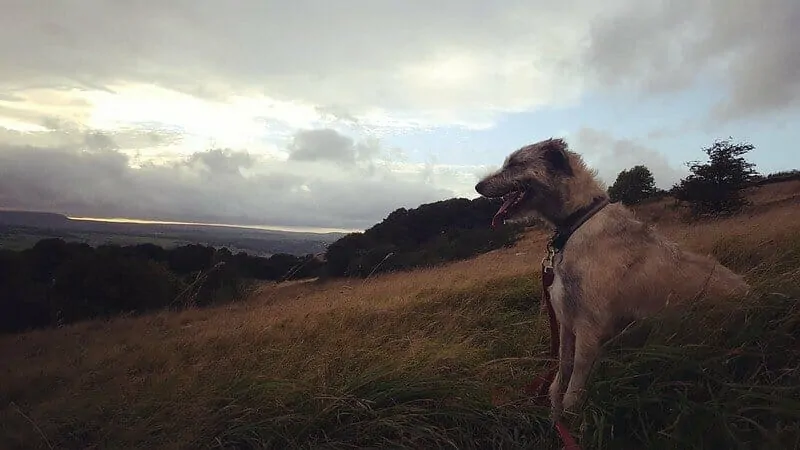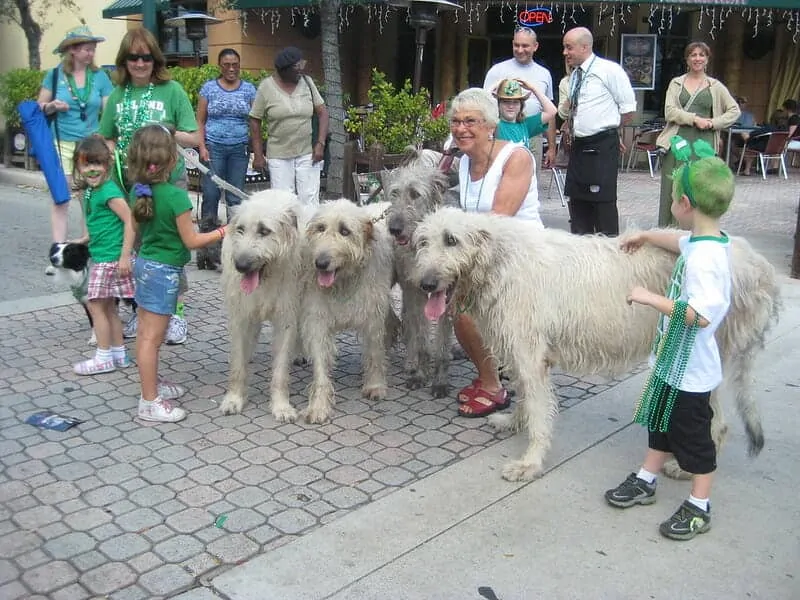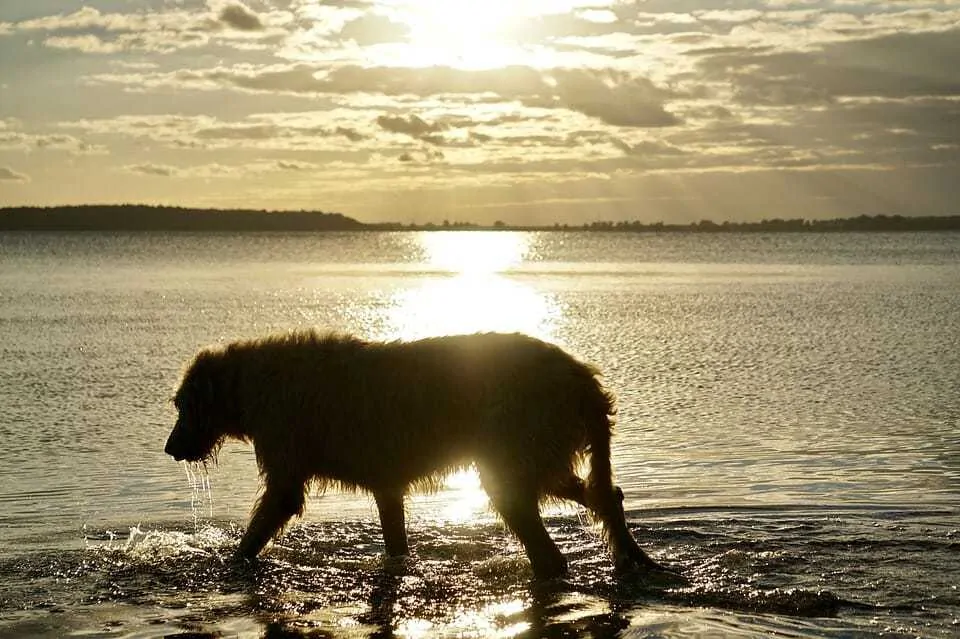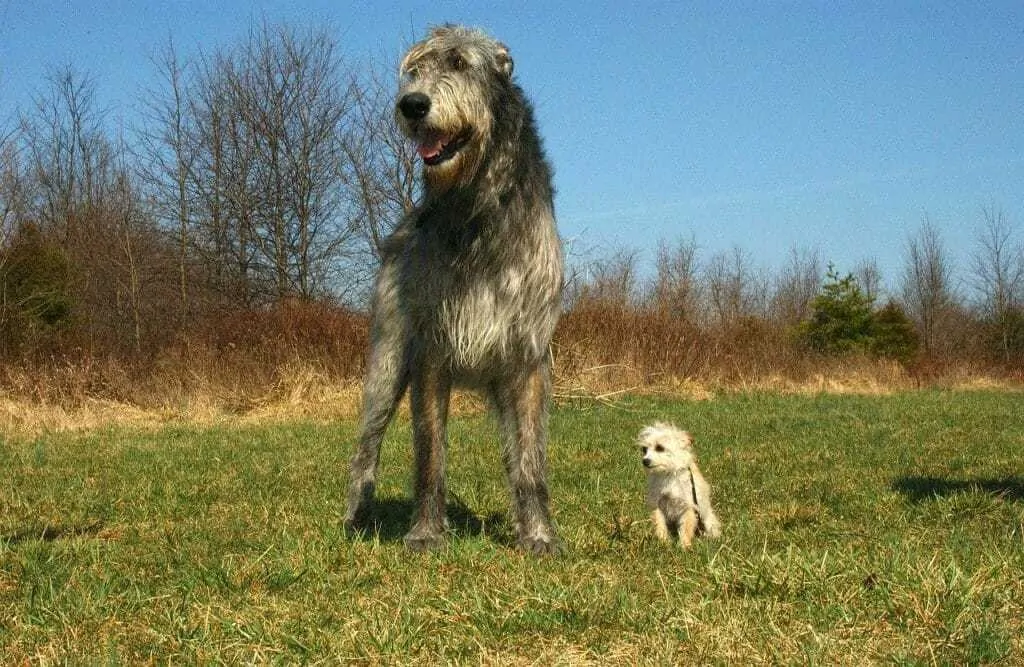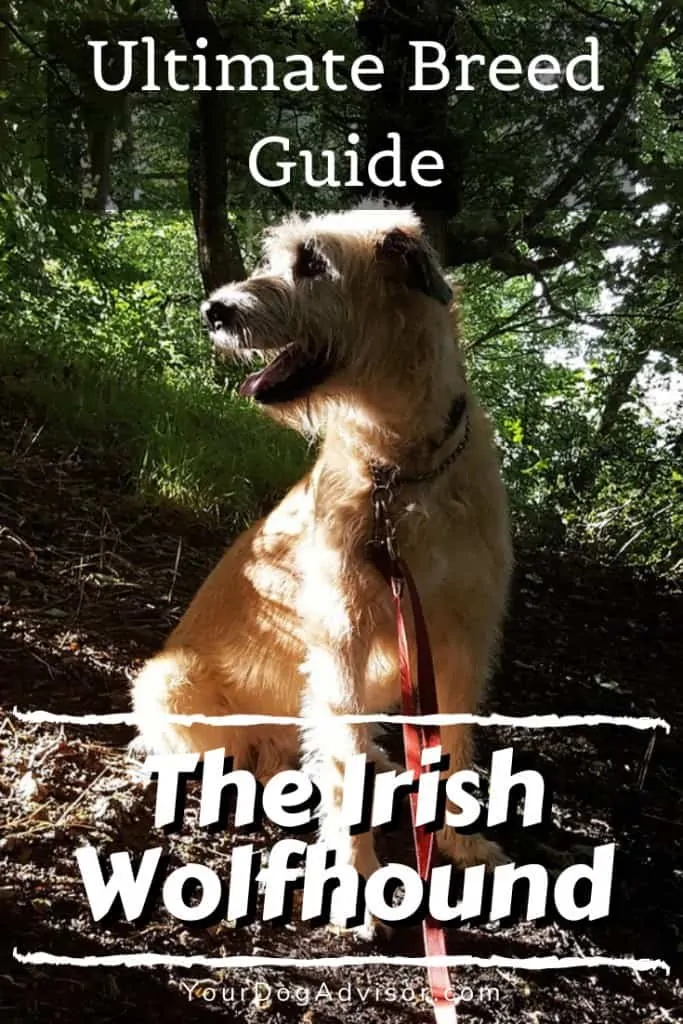Despite being the tallest dog breed and one of the most common sights in medieval Hollywood films, the Irish wolfhound is much rarer than their notoriety would suggest. Which is a shame given this breed’s affectionate temperament, calm disposition, and elegant beauty.
If you’ve ever considered adding an Irish wolfhound to your pack, you’ll want to read on to find out what makes this majestic dog so unique, and why they aren’t as popular today as they were five hundred years ago.
Contents
General Characteristics of the Irish Wolfhound
- Other names: Irish Greyhound, Wolf Dog of Ireland
- Height: 30 inches minimum for females, 32 inches minimum for males
- Weight: Minimum 105 pounds for females, over 120 pounds for males
- Lifespan: About 7 years
- Origin: Ireland
- Colors: Grey, black, brindle, white, wheaten, fawn
- Activity level: Moderate
- Grooming needs: Minimal
- Best suited for: Homes with large yards or more active families and individuals
IWs are a kind-natured breed that comes in an extra-large package. While their temperament makes them great for many situations, their large size can lead to trouble fast with an inexperienced owner.
The History of the Irish Wolfhound
The Irish wolfhound is one of the older modern breeds, with records of wolfhound type dogs in Ireland and Europe as far back as 300 B.C. In 391 A.D. the Roman Counsel received a gift of seven dogs from the Gaels to be used to fight lions and bears. These dogs were said to be viewed with wonder by all of Rome.
While these early dogs no doubt resembled modern IWs in terms of having a sleek but powerful sighthound build with enough strength to fight large carnivores, it is unlikely they were anywhere near as large as IWs today. In fact, in reviewing historical records of dog bones from the area, no canines that large are thought to have existed in Ireland before 1200 A.D.
More than likely, the wolfhounds’ great size didn’t become a common trait of the breed until long after the fall of Rome.
What we do know, is that the IW was used to hunt wolves and other large game in Ireland through the Middle Ages and up until the late 1700s. During this time, royal families outside of Ireland took an interest in these majestic beasts and they were often given as gifts to other kingdoms and houses.
Before 1200 A.D., the Irish Greyhound was a much smaller breed. As time went on, this dog gained height and mass as well as popularity across Europe.
This outsourcing of IWs combined with the complete eradication of wolves from Ireland eventually led to the downfall of the breed. In the late 1800s, a man named George Augustus Graham took a keen interest in the now “extinct” breed and attempted to resurrect it. But so few individuals were left, that he was forced to recreate the original breed by crossing Scottish deerhounds, great Danes, borzoi, and even a Tibetan wolfdog, most likely the rare Tibetan Kyi Apso.
Today’s Irish wolfhound shares very little of its DNA with the original members of the breed. But the look and temperament of the new breed have been carefully crafted to mirror that of the famous wolf dogs recorded throughout history.
The Temperament of the Irish Wolfhound
The original wolfhounds were often described by the phrase, “gentle when stroked, fierce when provoked.” For so many of this breed today, that idiom still holds true.
Despite their formidable size, these pups make loving, loyal companions and poor guard dogs. They are often friendly with strangers, and, while they may be protective of their people, are not apt to defend property or objects.
<iframe width=”560″ height=”315″ src=”https://www.youtube.com/embed/6U4M4zShdd4″ frameborder=”0″ allow=”accelerometer; autoplay; encrypted-media; gyroscope; picture-in-picture” allowfullscreen></iframe>
Learn more about the Irish Wolfhound by watching this Dogumentary TV video.
These dogs are strongly independent and often have a mind of their own, but they do not enjoy being alone and can become destructive if kept away from their owner for too long. However, in the right environment, these dogs are rarely destructive or messy, despite their large size.
Puppies and adolescent dogs require a fair amount of exercise and mental stimulation. As IWs age, they will still require some release for their energy but are happy to spend much of their time lounging around the house.
So what can provoke these gentle giants? Less than you might think.
While the original wolf dogs were known to aggressively take down wolves and bears, the modern breed retains very little of this trait. From the deerhound influence, they still hold on to a lot of sighthound instinct and will chase other dogs, animals, and even energetic children, but rarely with an aggressive edge. If they feel threatened or, worse, feel their family is in danger, they can be provoked into acting aggressively, but this is not a common occurrence.
>>>While IWs don’t actually have any wolf in their blood, wolf-dog hybrids do. If you’ve ever considered a hybrid, make sure you read up on the breed here first.
IWs are well known for their sensitivity to their human’s emotional state and often react to sadness by pouring on affection. This trait, as well as their tendency to be both stoic and calm, makes these dogs an especially great choice for therapy work. It also helps that they are tall enough to rest their heads on hospital beds without having to jump up.
While most depictions of IWs usually have them standing stoically or lounging in front of the hearth, it is important to remember that these dogs were built to move. A large yard or access to an enclosed space where you can let your IW run is a must for their mental health. “Molly – April 2009” by Airwolfhound / CC BY-SA 2.0
Health Issues Common to the Irish Wolfhound Breed
Like most giant breeds, the Irish wolfhound has a shorter than average lifespan and a number of common health issues. Joint problems, bone cancer, and bloat are often seen in these dogs. Beyond the typical giant dog issues are some problems specific to the breed, such as dilated cardiomyopathy and intrahepatic portosystemic shunt.
Here is a full list of health problems common to the IW:
- Bone Cancer
- Hip Dysplasia
- Dilated Cardiomyopathy
- Von Willebrand’s Disease
- Progressive Retinal Atrophy
- Megasophoglese
- Bloat
- Intrahepatic Portosystemic Shunt
A large majority of IWs die of bone cancer. To reduce the odds of acquiring a puppy with a genetic predisposition for this condition, make sure you only purchase from responsible breeders. These breeders will screen their dogs for health issues like this and stop breeding dogs who produce offspring affected by the condition.
These puppies don’t stay small for long. If you are considering getting an IW puppy, make sure you are prepared with an extra-large adjustable kennel and lots of large breed puppy food. “Molly – August 2006” by Airwolfhound / CC BY-SA 2.0
As an IW owner, you can also take steps to help protect your hound from this fate. IW puppies should only be fed high-quality puppy food marketed specifically for large breeds. Unlike normal puppy food which is very high in calories to support rapid growth, large breed puppy foods are less calorie dense and contain a very specific amount of calcium and phosphorous.
These two minerals, in combination with calorie intake, determines how fast a puppy grows and how well their bones form as they grow. Large breed dogs that grow too fast are much more likely to suffer from joint and bone issues as adults, such as dysplasia and arthritis. This can also affect an IW’s likelihood of developing bone cancer.
In addition to nutrition, there is mounting evidence that postponing neutering can significantly reduce dogs’ chances of getting bone cancer. Hormones, especially testosterone in males, helps regulate growth. When these hormones are removed through neutering before the dog reaches sexual maturity, it disrupts the growing process and can postpone growth plate closure. This, in turn, can lead to a number of joint and bone issues and an increased risk of osteosarcoma.
Neutering your dog is an important step to help control the pet population, control certain behavioral problems, and reduce the risk of certain diseases like mammary cancer. So you will have to weigh the costs and benefits to determine the best age for neutering your dog. In general, for giant breeds, neutering is not recommended before 18 months of age. This is assuming you can keep your dog contained to prevent unwanted litters, they have no overt aggression issues, and that you can put up with the antiques of an intact adolescent.
>>>Whether your dog is neutered or not, you may experience humping behavior. Here are five reasons why this occurs and what to do about it.
One simple way to avoid such a monumental decision is to opt to adopt a wolfhound instead of buying a puppy. There are many adult IWs out there in search of their forever home. Considering contacting your local IW rescue today for more information.
While these dogs may be short-lived, they have a lot of love to give during their time with us. Make sure you are prepared to pay them back with plenty of long walks and tons of affection. “Irish Wolfhounds” by Gareth Da’Bell / CC BY-NC 2.0
Do Irish Wolfhounds Do Well With Children and Other Pets?
IWs have a reputation for being calm and affectionate with their families, and this includes children. Their tolerance for rough play makes them a great choice for younger kids, but be aware that their large size can also pose a risk, especially if the dog is younger and more rambunctious.
Of course, all dogs are individuals, so always use caution and never leave a dog and child unsupervised.
Like all sighthounds, some care should be taken when introducing an IW to smaller pets such as cats and rodents. Typically, these dogs are very gentle with any animal or human they consider family and are likely to do fine with furred and feathered siblings if they are brought up together.
In general, IWs do well with other dogs. Their laid back personalities and formidable size mean that altercations rarely arise. But, in the case that another acts aggressively toward them or they perceive them as a threat, especially to their family, don’t be surprised if your IW reacts in kind. These are big, powerful dogs originally bred to hunt large carnivores and they can do some damage if provoked.
These giant dogs typically enjoy the company of kids and are very tolerant. They also make great therapy dogs. “Irish Wolfhound Pack” by Jodi Marr / CC BY-NC 2.0
What to Consider Before Bringing Home an Irish Wolfhound
Are you considering one of these gentle giants for your home? Before you commit, here are a few more items worth considering.
Activity Level
Much like their great Dane predecessors, IWs tend to be very laid back in the house, but rowdy when given enough space. Younger IWs, especially, will benefit from an outlet for their energy. Consider lure coursing competitions, tracking, or other canine sports to wear your pup out.
Older dogs will do well with a long daily walk or some playtime in the backyard. Because of their calm nature indoors, these dogs can do surprisingly well in apartments as long as they receive plenty of exercise and enough one-on-one time with their owners. Still, these big dogs prefer a large well-fenced yard so they can stretch their legs at will.
Beyond basic activity, IWs thrive in situations where they can be with their family more often than not.
>>>Think a smaller dog might be better for your small apartment? Here are the fifteen best apartment breeds.
Trainability
IWs are very smart and typically easy to train. They can be sensitive and respond best to positive, consistent training. As with all large dogs, starting training early on in puppyhood is a good way to set some ground rules before your dog gets to a point where they weigh more than you. Leash training and recall are especially important lessons for these giants. As much as they enjoy their families, they were bred to work and think independently, a trait that can get them into trouble if they are given too much freedom outside.
As much as IWs love their people, they can be very independent and become introverted if not properly socialized. Introducing your IW to lots of different situations when they are young will help them grow into well-rounded adults.
Grooming
The IW coat is coarse on the outside with a softer second coat underneath. Unlike most dogs that shed twice a year, these hounds tend to shed a little all year long. The occasional bath and frequent brushing will be enough to keep their coats healthy. But don’t expect them to look “groomed” for long. Their rough coat has a natural unkempt look to it that can’t be brushed away.
Like all breeds, they do require frequent nail trims.
Nutrition
As mentioned above, IW puppies should be provided with high-quality large breed puppy food until they reach their adult size. This can take more than a year, so be prepared to invest a good deal of money upfront for dog food. Spending the extra cash now for a quality diet will save you money as your dog ages.
IWs do not typically have a problem with weight gain. As long as you provide a quality diet with lots of protein and healthy fat, they should maintain a good weight even into their golden years. Like all giant breeds, expect to spend a large portion of the budget on dog food.
Cost
Most purebred Irish wolfhound puppies will cost you over a grand, possibly up to $6,000 depending on the breeder. Even after you bring a new pup home, expect to spend a significant amount of money on food. IWs age rapidly and, with their shortened lifespan, you should be prepared for rising health costs earlier than with most breeds.
>>>Click here to find out how much it really costs to own a dog.
9 Fun Facts About the Irish Wolfhound
Now that you know a little more about owning and caring for an Irish wolfhound, here are some fun facts about the breed.
- They are considered the tallest dog breed in the world.
- Irish royalty used to keep these dogs by the hundreds.
While the current world record holder for the tallest dog may be a great Dane, the IW is considered the tallest breed in the world given the height required in the breed standard.
- A still-growing IW puppy can weigh over 100 pounds.
- In 1571, the author Edmund Campion described the Irish Greyhounds as being “bigger of bone and limb than a colt.”
- A monument featuring a life-sized IW at Gettysburg that was erected in 1888 contains an inscription that describes the Irish Wolfhound as haven been extinct for over 100 years.
- IWs are said to have been used in war to drag soldiers off their horses.
- The IW can come in many colors but always has a “frosted” appearance due to their coarse outer coat.
- The number of IWs got so low in Ireland that at one point they were no longer allowed to be taken out of the country. Unfortunately, their numbers continued to dwindle until they were written off as extinct in the late 1700s.
- Most modern-day IWs share very little DNA with the original members of the breed.
Before You Go
Wondering if there may be a breed out there better suited for your lifestyle? Here are some more Ultimate Breed Guides to check out:
“Irish Wolfhounds” by Gareth Da’Bell / CC BY-NC 2.0

Sara Seitz has spent most of her life in the pet industry and has a bachelors in animal behavior from Colorado State University. Sara started working with dogs and cats as a high schooler at a rural boarding kennel. There she learned a lot about the bad and the ugly of the pet service industry. But not even the toughest day at that job would dissuade Sara from following her dream of working with animals.
In college, Sara got a job at a dog daycare and boarding facility in Fort Collins, Colorado. Her new career provided even more opportunities for learning about dog behavior than her classes did. As general manager of the daycare, Sara helped the company launch a new in-home pet sitting branch and trained to become a certified dog trainer. Between shifts taking care of peoples pets in-home and supervising dogs during playtime at the daycare, Sara organized and taught obedience classes.
Sara has always been passionate about bettering the lives of our canine companions. She soon found that advocating for and educating owners in the power of positive reinforcement training was one of the best ways to help dogs and their owners live happier lives.
